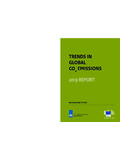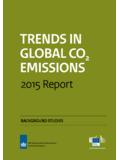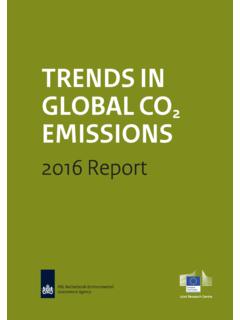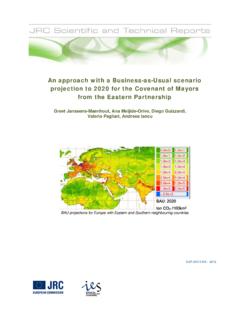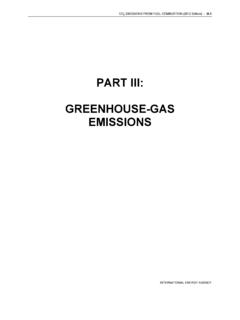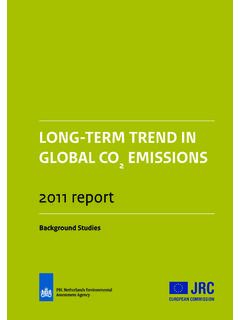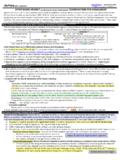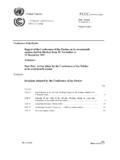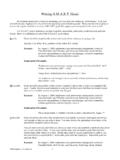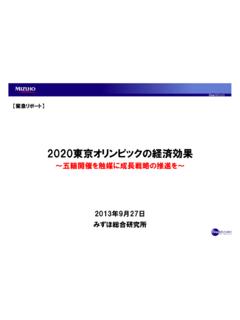Transcription of TRENDS IN GLOBAL CO2 EMISSIONS - …
1 TRENDS IN. GLOBAL CO2. EMISSIONS . 2014 Report BACKGROUND STUDIES. TRENDS in GLOBAL CO2 EMISSIONS : 2014 Report TRENDS in GLOBAL CO2 EMISSIONS : 2014 Report Graphics PBL Netherlands Environmental Assessment Agency Beeldredactie PBL. The Hague, 2014. ISBN: 978-94-91506-87-1 Production coordination PBL publication number: 1490 PBL Publishers JRC Technical Note number: JRC93171. Layout Corresponding author Textcetera, The Hague Acknowledgements Authors This report was drafted with input from many colleagues, Jos Olivier (PBL), Greet Janssens-Maenhout (IES-JRC), gathered over several years. The authors would like to Marilena Muntean (IES-JRC), Jeroen Peters (PBL) thank Pieter Boot (PBL), Frank Dentener (JRC-IES), Stefano Galmarini (JRC-IES), Laurens Brandes and Michel Responsibility den Elzen (both PBL) for their review.
2 We also like to PBL Netherlands Environmental Assessment Agency thank Bob Andres (ORNL), Thomas Willem van Ierland Institute for Environment and Sustainability (IES) of the (EC, CLIMA) and Roberta Quadrelli (IEA) for their critical European Commission's Joint Research Centre (JRC) review and suggestions, and USGS and IEA for providing recent statistics and Grainne Mulhern (JRC-IES) for the Editing proofreading. PBL and JRC. This publication can be downloaded from: or Parts of this publication may be reproduced, providing the source is stated, in the form: Olivier JGJ, Janssens-Maenhout G, Muntean M and Peters JAHW (2014), TRENDS in GLOBAL CO2 EMISSIONS ; 2014 Report, The Hague: PBL Netherlands Environmental Assessment Agency; Ispra: European Commission, Joint Research Centre.
3 This CO2 report 2014 is one in a series of annual publications by PBL-JRC. After publishing web reviews in 2007 and 2008, the CO2. report series started in 2009 and provide up-to-date knowledge on the trend of GLOBAL CO2 EMISSIONS . CO2 emission estimates have been made by PBL Netherlands Environmental Assessment Agency and the European Commission's Joint Research Centre (JRC), on the basis of energy consumption data on 2010 to 2013, as published by British Petroleum, except for coal consumption in China over the 2012 2013 period, for which data were used as published by the International Energy Agency (IEA) and by the National Bureau of Statistics of China.
4 The estimations are also based on production data on cement, lime, ammonia and steel, as well as on EMISSIONS per country, from 1970 to 2010, from the Emission Database for GLOBAL Atmospheric Research (EDGAR) version FT 2010, developed jointly by JRC and PBL. The greenhouse gas EMISSIONS of from the EDGAR FT2010 data set have also been used for the GLOBAL EMISSIONS overviews in the Fifth Assessment Report of IPCC Working Group III on mitigation of climate change, combined with the latest estimates of the IEA on CO2 EMISSIONS from fossil fuel combustion. All reports are available from and PBL Netherlands Environmental Assessment Agency is the national institute for strategic policy analyses in the fields of the environment, nature and spatial planning.
5 We contribute to improving the quality of political and administrative decision-making, by conducting outlook studies, analyses and evaluations in which an integrated approach is considered paramount. Policy relevance is the prime concern in all our studies. We conduct solicited and unsolicited research that is both independent and always scientifi- cally sound. As the Commission's in-house science service, the Joint Research Centre's mission is to provide EU policies with independent, evidence-based scientific and technical support throughout the whole policy cycle. Its work has a direct impact on the lives of citizens by contributing with its research outcomes to a healthy and safe environment, secure energy supplies, sustainable mobility and consumer health and safety.
6 Working in close cooperation with policy Directorates-General, the JRC addresses key societal challenges while stimulating innovation through developing new methods, tools and standards, and sharing its know-how with the Member States, the scientific community and international partners. Contents Summary 4. 1 Introduction 6. Methodology and data sources used 6. 2 Results 10. Slowdown in the increase in GLOBAL CO2 EMISSIONS confirmed and continued 10. Different TRENDS in the six largest emitting countries/regions 13. Comparison between EMISSIONS in the various countries 24. CO2 EMISSIONS from oil and gas production 28.
7 Gas and oil production by hydraulic fracturing and oil sands exploitation 29. CO2 from cement and steel production (non-combustion) 31. Comparison with other GLOBAL greenhouse gas inventories 34. 3 What controls CO2 EMISSIONS from energy supply and consumption 36. Introduction 36. TRENDS in GLOBAL fossil-fuel consumption and fuel mix 37. TRENDS in renewable energy sources 39. TRENDS in nuclear energy 41. Annex 1: Methodology and data sources over the 2010 2013 period 44. List of abbreviations and definitions 50. References 52.. Summary GLOBAL carbon dioxide (CO2) EMISSIONS from fossil fuel States increased its CO2 EMISSIONS for the first time in combustion and from industrial processes (cement and five years by , compared to 2012.)
8 The EU28's CO2. metal production) increased in 2013 to the new record of EMISSIONS , which started to decrease in 2006, continued billion tonnes (Gt) CO2, which is Gt higher than to decrease by in 2013, and at a larger rate than in last year's record. This moderate increase of 2% in 2013 2012. Other OECD countries also mainly show decreases compared to 2012 is a continuation of last year's trend or minor increases below 2%. Russia's EMISSIONS and of the slowdown in the annual EMISSIONS growth. decreased by In contrast, CO2 EMISSIONS in The actual increase of 2012 compared to 2011 was emerging economies mainly increased in 2013, compared Gt or (excluding leap year correction) and both are to 2012 ( in India by , in Brazil by and in about half the average annual growth rate of Gt or Indonesia by ).
9 Since 2003 (excluding the 2008 2009 recession years). Note that the average annual emission increase In 2013, the Chinese per capita CO2 level of tonnes CO2/. in the 1995 2002 period (after the large decline in energy cap exceeded the mean EU28 level of tonnes CO2/cap, consumption in the former Soviet Union countries) but remained still under half the US level of tonnes was about or Gt CO2 per year. With the GLOBAL CO2/cap. Evaluating the emitted CO2 per Gross Domestic economic growth of and , in 2012 and 2013 Product (corrected for purchasing power parity) (PPP)), respectively, a further decoupling of the GLOBAL economic China is still scoring high with 650 kg CO2/1000 USD of and emission TRENDS can be observed.
10 This decoupling GDP, which is more than Russia (530 kg CO2/1000 USD), is consistent with the increasing service sector share almost double that of the United States (330 kg CO2/1000. (growing by and in 2012 and 2013 on average in USD), and almost triple that of the EU28 (220 kg CO2/1000. middle income countries, including China) to the overall USD). This is due to a relative high energy intensity of the gross domestic product, at the expense of more energy- sector contributing to GDP growth in China, even though intensive industrial activities. the intensity continued to decline by in 2013, compared to in 2012. Although China needs fuel to The GLOBAL increase in CO2 EMISSIONS largely reflects the drive its economic development, it will need a stronger increase in fossil energy consumption, driven mainly by decrease in consumption next year to meet the 12th Five emerging economies with a steadily increasing energy Year Plan target for 2015 of a cumulative 17% reduction in use over the past decade.
